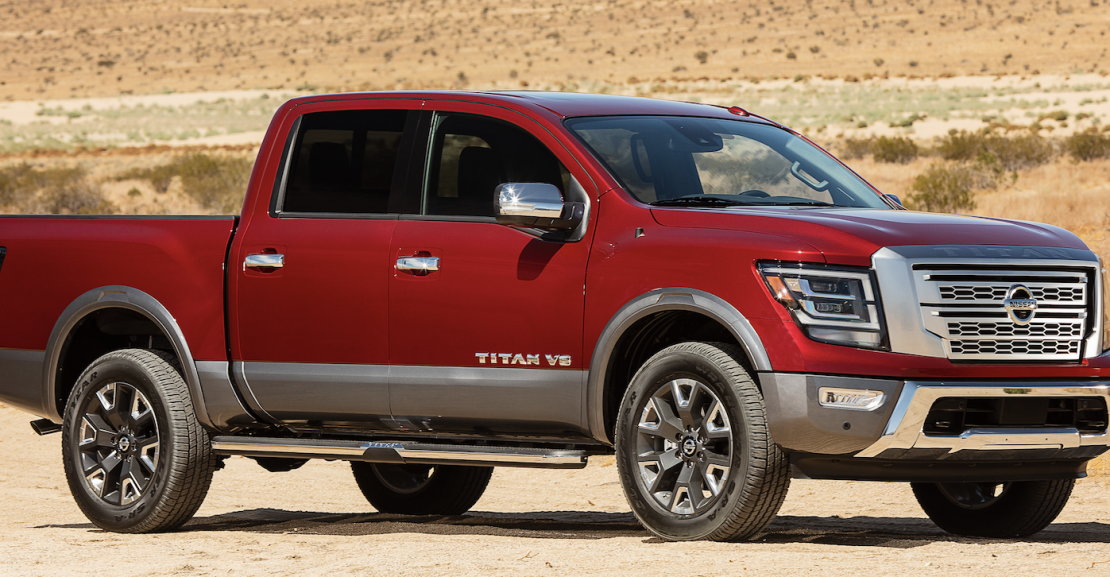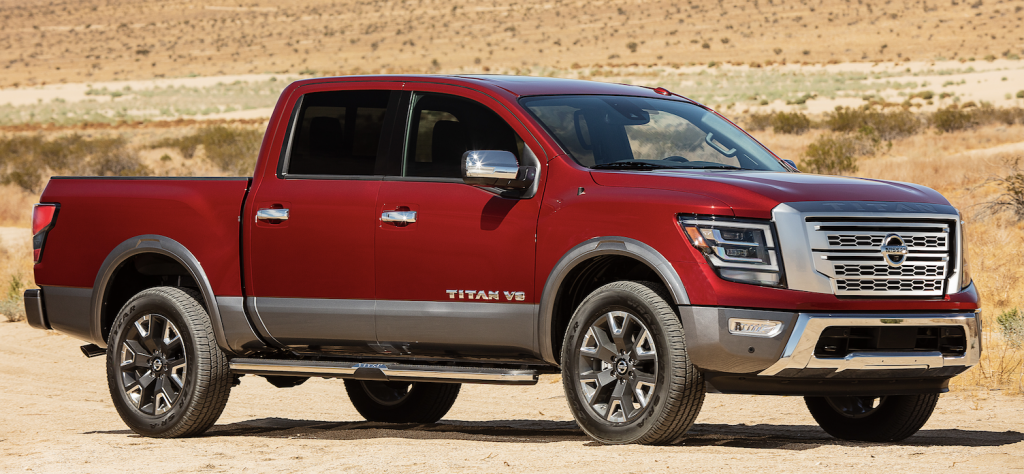

In a class that divides roughly 2.4 million annual sales between just six entries with average transaction prices reaching $48,000, Nissan’s Titan has long run a distant last. While it’s unlikely this recent update will change that, it may well result in a bigger slice of this very lucrative pie.
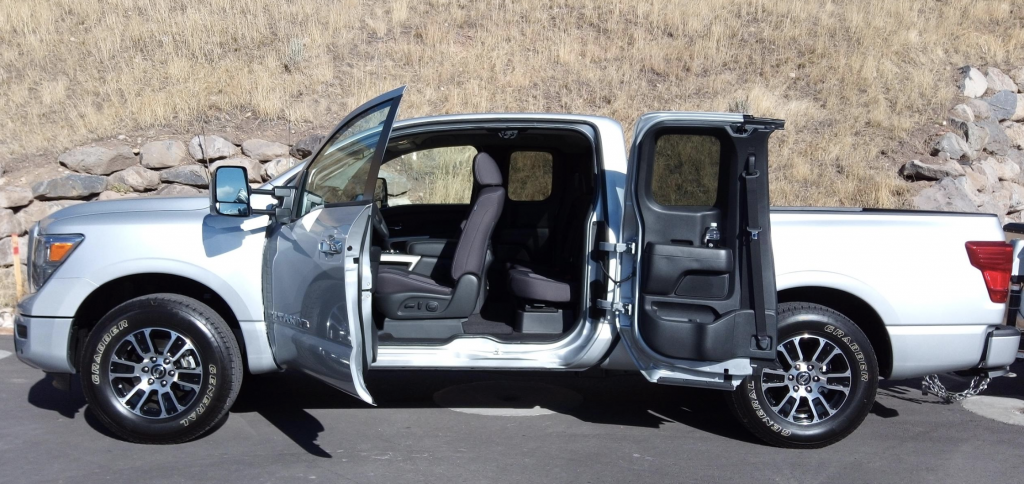
And Nissan is hoping to do it despite a trimmed model lineup. Gone are regular-cab models (nowadays primarily purchased as commercial vehicles) along with King Cab (extended cab) and 5.0-liter V8 turbodiesel versions of the “heavy half-ton” Titan XD. That leaves the regular Titan in King Cab (with 6.5-foot bed) and Crew Cab (with 5.5-foot bed) body styles, and the Titan XD in a lone Crew Cab body style with 6.5-foot bed. All are powered by a 5.6-liter V8 with a slight power boost to 400 horsepower (from 390) and 413 lb-ft of torque coupled to a new 9-speed automatic transmission that replaces a 7-speed, with a choice of either rear-wheel drive or a part-time 4-wheel-drive system with low-range gearing.
First Spin: 2019 Chevrolet Silverado
Regular Titans have a maximum payload and towing capacity of 1680 lbs and 9370 lbs, respectively, while the XD maxes out at 2450 lbs and 11,000 lbs, respectively. EPA fuel-economy estimates had not been released at the time of this writing.
Trim levels for both regular and XD models ascend through base S, mid-level SV and SL, luxury Platinum Reserve, and off-road-oriented PRO-4X. S and SV come with a front bench seat for 6-passenger capacity. Optional on the SV and standard on higher-line models are front bucket seats that cut seating capacity to five.

Aside from some styling tweaks that result in a bolder appearance with more emphasis placed on the Titan model name, the biggest news for the 2020 refresh is the addition of a number of new features, many – particularly on the safety front – being standard.
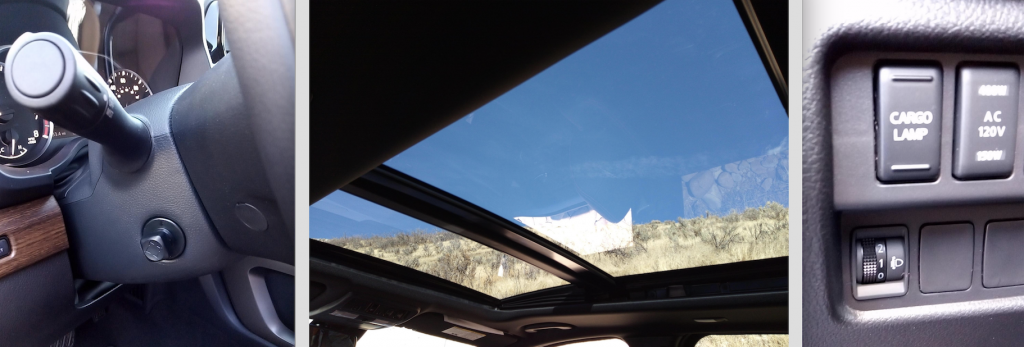
New for 2020 is a dual-pane glass sunroof available on SL, Platinum Reserve, and PRO-4X, which Nissan says is the only one in the class that preserves the overhead grab handles. New for PRO-4X is an off-road gauge display that — among other things — provides an inclinometer.
But some of what Nissan says are class-exclusive safety features are among the biggest things Titan brings to the full-size pickup party. Standard on all models is Nissan’s Safety Shield 360 suite of high-tech safety features, which includes forward collision warning with automatic emergency braking and pedestrian detection, blind-spot alert, lane-departure warning, rear cross-traffic alert, automatic high beams, and rare-for-the-class rear automatic braking. Also available are a 360-degree camera system, front and rear obstacle detection, and — new for 2020 — adaptive cruise control, driver attention warning, and traffic-sign recognition.
Another is power. Although top optional engines on GM and Ford pickups produce more, the Titan’s 400 horses beats anything offered by Ram or Toyota, and is by far and away the most powerful standard engine in the class. Whether this is reflected in performance will have to await a local test, as much of the driving on the preview near Park City, Utah, was held at 7000 feet of elevation, where more than 20 percent of the engine’s horsepower had evaporated – almost literally – into thin air. However, the new 9-speed automatic showed itself well, with fairly quick kickdowns when the throttle was stabbed at speed.
Roads in the area were fairly smooth, so ride was likewise difficult to judge, a more telling test also coming from a local drive in Chicago – where the suspension would be subjected to our infamously pockmarked streets. The only real trial in this regard came during off-road drives of Titan PRO-4X models, which handled the rough terrain with aplomb.
Test Drive: 2018 Ford F-150 SuperCrew Platinum
In terms of accommodations, the Titan has some hits and some misses.
For a large pickup, headroom and legroom in front are limited for really tall folks. In back, headroom beneath the newly available dual-panel sunroof of a tested Platinum Reserve Crew Cab might be tight for those over about 6 feet tall, though legroom would be ample. In a PRO-4X King Cab, legroom in back would probably be tight for a 6-footer if the seat ahead was pushed far back.

Visibility could also be better. The left-front roof pillar is very thick, blocking a lot of the view to that corner; the right side isn’t as bad. Side pillars are also thick, but those at the rear aren’t. Tall rear headrests block some of the view to the rear corners, and they don’t fold and are awkward to remove, the best option being to fold the rear seat back. A rearview camera is standard, as is – quite unusually – a 360-degree camera system, which displays on a large 8-inch screen and really helps when backing, maneuvering into a parking space, or pulling next to a curb. But tall front fenders and hood along with sheer size – all being normal these days – mean it’s still tricky to park a Titan.
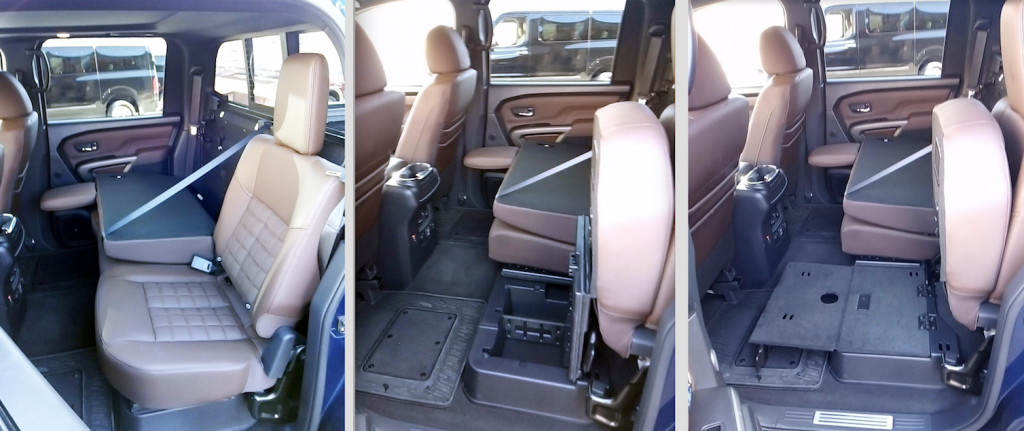
Better is cabin storage space. At least on the top-line Platinum Reserve we drove, there are the usual large areas – glovebox, console box, console cupholders/bins, sand door map pockets – along with handy side console bins, with two 12-volt plugs (one in the console box, the other above the forward console bin) and two USB ports. In back, there are six cupholders, 12-volt and 120-volt outlets, and two USB plugs. The seat backs fold forward to create a flat cargo surface, and the cushions flip up to reveal an under-seat bin whose lid can be folded out to form a platform.
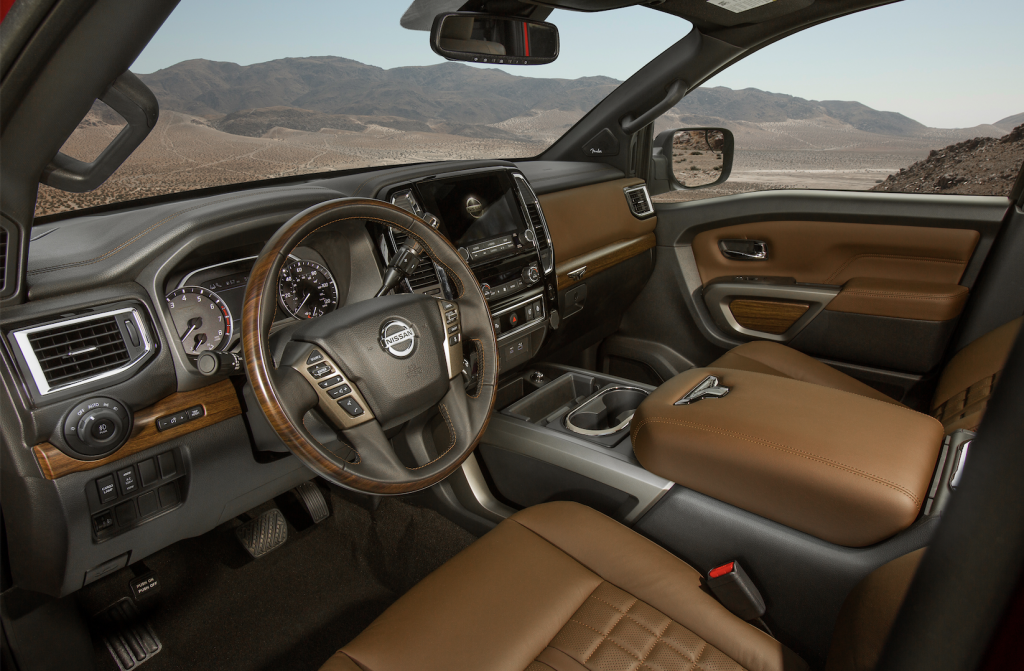
The Platinum Reserve also impressed for interior materials. Brown leather covered the seats and some padded panels, accented by no small amount of ritzy wood trim augmented with satin chrome and piano black accents. Altogether, very high class. A midlevel SV had mostly hard plastic surfaces, but looked far from cheap inside.
But pickups are all about the bed, and it doesn’t seem as though the Titan’s received much attention in the redesign. That’s not to say it’s deficient in any way, there’s just nothing new or creative.

The tailgate is damped, but you have to order an optional fold-down step to ease climbing into the bed (some rivals build a step into the bumper), which would benefit from a grab handle for helping yourself up. You can also order a 120-volt outlet for the side wall and large, lockable side-wall boxes that include covered corner bins (which don’t lock), along with the usual lights and tie-down rails. But while useful, the side-wall boxes aren’t as handy to access as Ram’s Ram Boxes, and the tailgate doesn’t have any “multi-function” capabilities like GMC’s MultiPro tailgate or Ram’s Multifunction Tailgate.
As mentioned, even the base S comes with a host of standard safety features. Also notably standard are all the expected features plus an 8-inch touchscreen, satellite radio, Apple CarPlay/Android Auto functionality, remote keyless entry, rearview camera, rear obstacle detection, manual sliding rear cab window, and trailer sway control. A spray-in bedliner and trailering package are optional.
Added on the SV are such items as alloy wheels, heated mirrors with integrated turn signals, Nissan Connect telematics services, and adaptive cruise control. More notable are the options that are made available, including 8-way power driver seat with heat and lumbar adjustment, 9-inch touchscreen with navigation system, power sliding rear cab window, remote engine start, dual-zone climate control, rain-sensing wipers, Homelink garage-door opener, front obstacle detection, tie-down rails/lights/110-volt outlet/fold-down step for the cargo bed, trailer brake controller, and extendable towing mirrors.

The SL makes some of those options standard along with chrome grille, LED headlights with height adjustment, 20-inch chrome wheels (replacing 18s), running boards, power mirrors, leather upholstery, power tilt/telescopic steering column, driver-seat memory, power passenger seat, 360-degree camera system, and Fender high-end audio system. Options made available include a dual-pane sunroof. Similar features are offered on the PRO-4X, which adds off-road items such as skid plates, 18-inch wheels with off-road tires, and 2-inch raised suspension, along with optional heated rear seats.
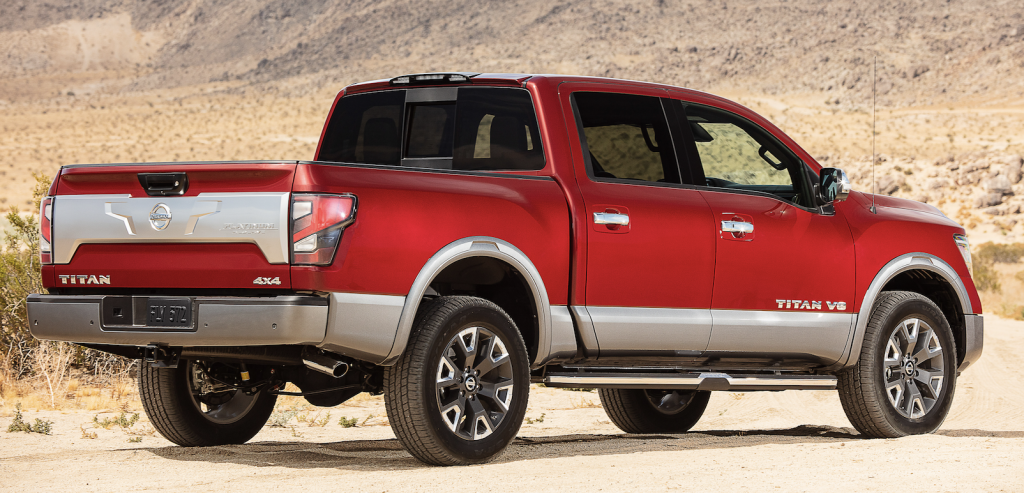
Exclusively offered on the top-line Platinum Reserve are a satin-chrome grille and tailgate trim, illuminated chrome running boards, two-tone lower-body color, and debossed leather upholstery and wood trim.
Test Drive: 2019 Toyota Tundra SR5 Double Cab 4×4
Although model choices have been cut considerably, Nissan says it’s concentrating its efforts on those that have proven most popular. Considering Titan’s low overall volume, that’s probably wise. And while prices have not yet been released — which means a value equation cannot yet be established — Titan offers an impressive selection of standard features along with some that are class exclusives. It also offers the segment’s longest bumper-to-bumper warranty of 5 years/100,000 miles. But that last item aside, while Titan may not be class-leading in any regard, it may well offer features many buyers want at Nissan’s traditionally competitive prices.
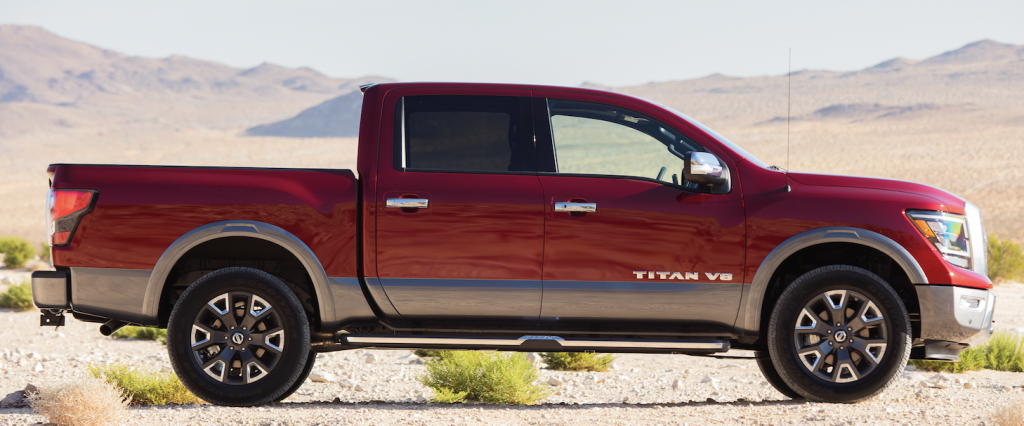
Check out our Large Pickup Truck Best Buys
Click here for a complete index of Consumer Guide Car Stuff Podcast episodes
2020 Nissan Titan

